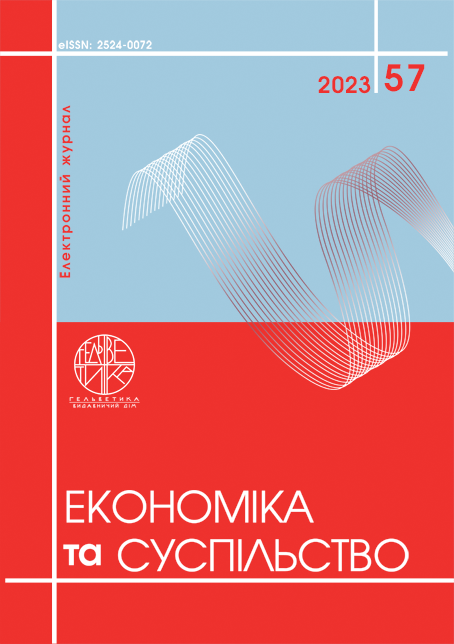NANOTECHNOLOGY SEGMENT OF THE GLOBAL MARKET: THE ASIAN MODEL
Abstract
The article examines the current issues of leadership of countries in the field of nanotechnology, and it is proved that during the last two decades, nanotechnology has become a key factor in the world economy, defining a qualitatively new economic system. This system is based on deep interactions between the participants of innovation processes. It has been updated that more than sixty countries are actively implementing state support programs for national nanotechnology industries due to the increase in the amount of state investments in this sector. It is proved that the Asian model of the development of the nanotechnology segment of the global market has its own specific features, which is implemented in Japan using a horizontal system of management of scientific and technological activities in this area based on the convergent unification into one thematic direction of isolated scientific developments of an informational, medical and biological profile . Japan's key competitive advantages in the field of state stimulation of the nanotechnology sector derive today from its focus on supporting fundamental and applied research in the field of neodymium magnets, lithium-ion batteries, blue LEDs, photocatalysts and carbon fibers. Taking into account the past global dominance of Japan in the electronic industry, this country still has all the prerequisites for increasing its competitive influence on the nanotechnology segment of the global market. The experience of China is analyzed and it is proven that in recent decades it has been actively moving forward along the global nanotechnological trajectory due primarily to the high level of financing of this sector, the growing reserve of scientific talents and diversified channels of international scientific and technological cooperation. Modern state support for the development of nanotechnological sectors today focuses on increasing the competitiveness of developed nanotechnologies through their large-scale legislative and regulatory support. In general, the financing of the nanotechnological sectors of national economies is carried out mainly on the basis of their direct state financing, the value volumes of which, as of now, have not yet reached their maximum values.
References
EU Business in Japan. About Nanotechnology. URL: https://www.eu-japan.eu/eubusinessinjapan/sectors/nanotechnology/about-nanotechnology (дата звернення 30.11.2023 р.).
Nanotechnology and Materials R&D in Japan: An Overview and Analysis CRDS-FY2017-XR-02 March 2018. URL: https://www.jst.go.jp/crds/pdf/en/CRDS-FY2017-XR-02.pdf (дата звернення 30.11.2023 р.).
Ісакова Н. Б. Досвід співробітництва між університетами і промисловістю в Японії. Наука та наукознавство. 2023. № 1 (119). С. 121-141. URL: https://sofs.org.ua/wp-content/uploads/2023/03/Nauka_ta_Naukoznavstvo_1-2023-121-148-1-21.pdf (дата звернення 02.12.2023 р.).
Галан Н. І. Японські університети у «потрійній спіралі»: приклад Тохоку. Наука та інновації. 2010. № 3 (6). С. 55-65.
Halder В. How China is the Future of Nanoscience. OZY, 2020. URL: https://www.ozy.com/the-new-and-the-next/cloning-to-cancer-china-is-driving-the-future-of-small-science/256094/ (дата звернення 02.12.2023 р.).
Siddiki M. K. China as the World Leader in Nanotechnology: Another Wakeup Call for the West. Small Wars Journal, 03.12.2022. URL: https://smallwarsjournal.com/jrnl/art/china-world-leader-nanotechnology-another-wakeup-call-west (дата звернення 02.12.2023 р.).
Jarvis D. S. L., Richmond N. Regulation and Governance of Nanotechnology in China: Regulatory Challenges and Effectiveness. Eur. J. Law Technol. 2011. Vol. 2. No. 3. P. 1-11.
Leading 50 Chinese institutions in chemistry. 2021. URL: https://www.natureindex.com/supplements/nature-index-2021-china/tables/chemistry (дата звернення 02.12.2023 р.).
Nanotechnology in China: Market Report. AZO Nano. 2015. URL: https://www.azonano.com/article.aspx?ArticleID=3545 (дата звернення 02.12.2023 р.).
EU Business in Japan (2023). About Nanotechnology. Available at: https://www.eu-japan.eu/eubusinessinjapan/sectors/nanotechnology/about-nanotechnology .
Nanotechnology and Materials R&D in Japan (2018): An Overview and Analysis CRDS-FY2017-XR-02 March 2018. Available at: https://www.jst.go.jp/crds/pdf/en/CRDS-FY2017-XR-02.pdf.
Isakova N. B. (2023) Dosvid spivrobitnytstva mizh universytetamy i promyslovistiu v Yaponii.[Experience of cooperation between universities and industry in Japan]. Nauka ta naukoznavstvo. vol. 1 (119). pp. 121-141. Available at: https://sofs.org.ua/wp-content/uploads/2023/03/Nauka_ta_Naukoznavstvo_1-2023-121-148-1-21.pdf.
Halan N. I. (2010) Yaponski universytety u «potriinii spirali»: pryklad Tokhoku. [Japanese universities in the "triple helix": the case of Tohoku].Nauka ta innovatsii. vol. 3 (6). рр. 55-65.
Halder В. (2020) How China is the Future of Nanoscience. Available at: https://www.ozy.com/the-new-and-the-next/cloning-to-cancer-china-is-driving-the-future-of-small-science/256094/
Siddiki M. K. (2022) China as the World Leader in Nanotechnology: Another Wakeup Call for the West. Small Wars Journal,. Available at: https://smallwarsjournal.com/jrnl/art/china-world-leader-nanotechnology-another-wakeup-call-west.
Jarvis D. S. L., Richmond N. (2011) Regulation and Governance of Nanotechnology in China: Regulatory Challenges and Effectiveness. Eur. J. Law Technol. Vol. 2. No. 3. P. 1-11.
Leading 50 Chinese institutions in chemistry. (2021). Available at: https://www.natureindex.com/supplements/nature-index-2021-china/tables/chemistry .
Nanotechnology in China: Market Report. (2015) AZO Nano. Available at: https://www.azonano.com/article.aspx?ArticleID=3545

This work is licensed under a Creative Commons Attribution 4.0 International License.


